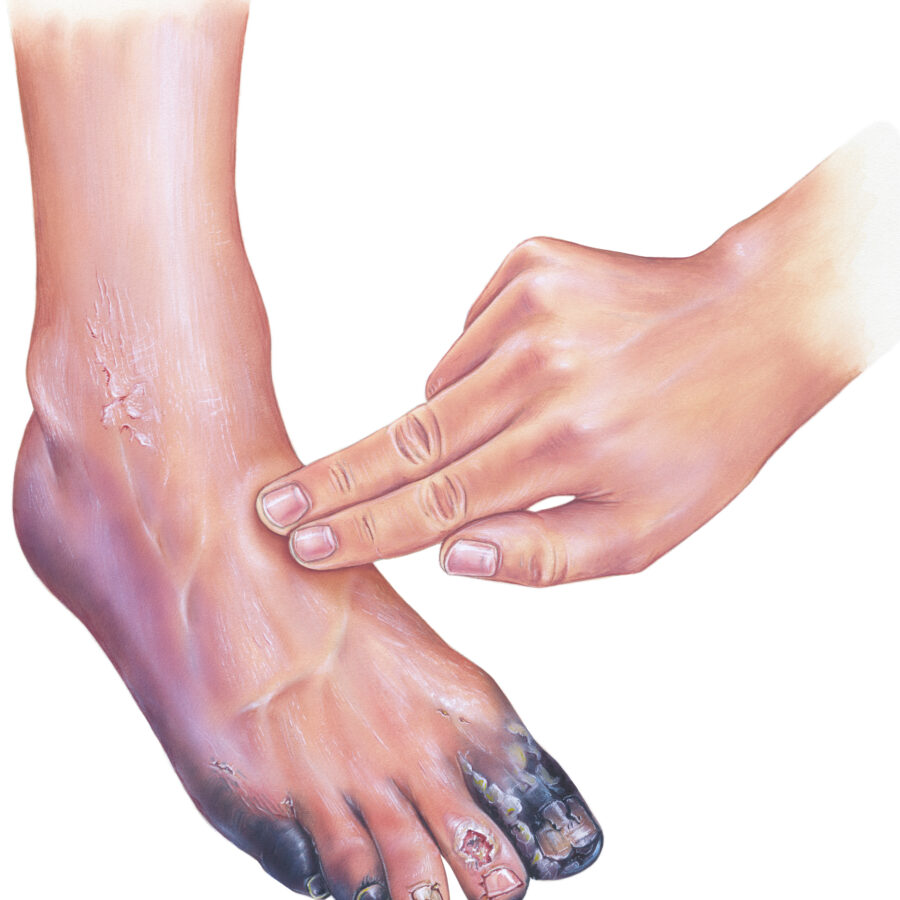
What is Critical Limb Ischemia (CLI)?
Critical limb ischemia (CLI) is a severe blockage in the arteries of the lower extremities, which severely reduces blood-flow. It is an advanced form of peripheral arterial disease, or PAD. PAD is caused by atherosclerosis, the hardening and narrowing of the arteries over time due to the buildup of fatty deposits and calcium, called plaque.
CLI is a chronic condition that results in numbness and severe pain in the feet or toes, even at rest. Complications of poor circulation can include sores and wounds that won’t heal in the legs and feet. Left untreated, the complications of CLI will result in amputation of the affected limb. CLI, also known as chronic limb-threatening ischemia, is a serious condition that increases your risk of heart complications, limb amputation, and death.
What are the Symptoms?
The most common symptom of chronic limb-threatening ischemia is called ischemic rest pain, an intense foot or leg pain. Often, this pain wakes you up at night. You may hang your leg off the edge of your bed or get up and walk around to relieve the pain. Some people don’t feel any pain, but notice other symptoms, such as:
- Numbness in your legs, feet, or toes
- Cold hands, feet, or legs
- Legs and feet that appear smooth, shiny, hairless, or very dry
- Weak or no pulse in your legs or feet
- Open sores, skin infections, or ulcers that won’t heal
- Skin discoloration or drainage from gangrene
- Thickening of the toenails
More on Critical Limb Ischemia
Is CLI Life-threatening?
Yes. Critical limb ischemia significantly increases your risk of major medical complications, including death. Within one year of developing critical limb ischemia:
- Almost 1 in 3 people have an amputation.
- About 1 in 4 people die, most commonly from heart disease or a stroke.
Who can Get CLI?
Anyone with PAD. Other risk factors include:
- Smoking and using tobacco products
- Chronic kidney disease
- Diabetes
- High blood pressure (hypertension)
- High cholesterol (hyperlipidemia)
- Overweight or obesity
- Sedentary lifestyle
- Family history of PAD or claudication
How is CLI Diagnosed?
Your doctor may suspect critical limb ischemia based on your symptoms. They will evaluate the blood flow in your hands, feet, and toes, and assess how quickly or thoroughly wounds heal.
Your doctor may identify the cause of blockages using one or more of the following:
- Ankle-brachial index (ABI)
- Doppler Ultrasound
- CT angiography
- Magnetic resonance angiography (MR angiography)
- Angiogram
Treatments and Outlook
What are the Treatment Options for CLI?
Endovascular treatments: Minimally invasive therapy is often an option. A device is inserted through a remote
puncture in the groin, foot/ lower leg or wrist.
Atherectomy: Uses a catheter with a rotating cutting blade.
Angioplasty: A tiny deflated balloon crosses a blockage and is then inflated opening up the lesion
Cutting balloon: A balloon embedded with micro-blades is used to dilate the diseased area.
Stents: Metal mesh tubes that provide scaffolding are left in place across a blockage holding it open.
Laser atherectomy: Small bits of plaque are vaporized by the tip of a laser probe.
Surgical treatments: Treatment of wounds or ulcers may require additional surgical procedures or other follow-up care. If the arterial blockages are not favorable for endovascular therapy, surgical treatment is often recommended.
If none of these treatments adequately restore blood flow, your healthcare provider may need to remove part of your finger, hand, toe, foot, or leg. About 1 in 5 people with critical limb ischemia eventually need an amputation. People with diabetes are much more likely to need an amputation.
What is the Outlook for Patients With CLI?
Chronic limb-threatening ischemia can lead to serious complications, including a shortened lifespan. If you have any chronic limb-threatening ischemia or PAD symptoms, see a healthcare provider right away. The earlier you get treatment, the less likely you will experience severe complications or need an amputation.